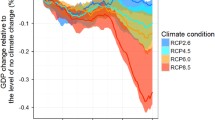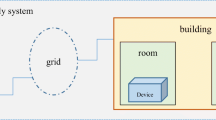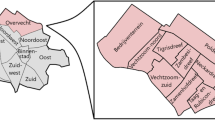Abstract
Climate change and energy service demand exert influence on each other through temperature change and greenhouse gas emissions. We have consistently evaluated global residential thermal demand and energy consumption up to the year 2050 under different climate change scenarios. We first constructed energy service demand intensity (energy service demand per household) functions for each of three services (space heating, space cooling, and water heating). The space heating and cooling demand in 2050 in the world as a whole become 2.1–2.3 and 3.8–4.5 times higher than the figures for 2010, whose ranges are originated from different global warming scenarios. Cost-effective residential energy consumption to satisfy service demand until 2050 was analyzed keeping consistency among different socio-economic conditions, ambient temperature, and carbon dioxide (CO2) emission pathways using a global energy assessment model. Building shell improvement and fuel fuel-type transition reduce global final energy consumption for residential thermal heating by 30% in 2050 for a 2 °C target scenario. This study demonstrates that climate change affects residential space heating and cooling demand by regions, and their desirable strategies for cost-effective energy consumption depend on the global perspectives on CO2 emission reduction. Building shell improvement and energy efficiency improvement and fuel fuel-type transition of end-use technologies are considered to be robust measures for residential thermal demand under uncertain future CO2 emission pathways.














Similar content being viewed by others
References
Akimoto K, Sano F, Homma T, Oda J, Nagashima M, Kii M (2010) Estimates of GHG emission reduction potential by country, sector, and cost. Energy Policy 38:3384–3393
Akimoto K, Sano F, Hayashi A, Homma T, Oda J, Wada K, Nagashima M, Tokushige K, Tomoda T (2012) Consistent assessments of pathways toward sustainable development and climate stabilization. Nat Res Forum 36(4):231–244
Akimoto K, Sano F, Homma T, Tokushige K, Nagashima M, Tomoda M (2014) Assessment of the emission reduction target of halving CO2 emissions by 2050: macro-factors analysis and model analysis under newly developed socio-economic scenarios. Energy Strategy Reviews 2:246–256
Daioglou V, Van Ruijven BJ, Van Vuuren DP (2012) Model projections for household energy use in developing countries. Energy 37:601–615
De Lucena AFP, Schaeffer R, Szklo AS (2010) Least-cost adaptation options for global climate change impacts on the Brazilian electric power system. Glob Environ Chang 20:342–350
DEWHA (2008) Energy Use in the Australian Residential Sector
DOE (2011) Buildings Energy Data Book, http://buildingsdatabook.eren.doe.gov/
Grübler A (1990) The rise and fall of infrastructures: dynamics of evolution and technological change in transport. Physica-Verlag, Heidelberg
Hayashi A, Akimoto K, Sano F, Mori S, Tomoda T (2010) Evaluation of global warming impacts for different levels of stabilization as a step toward determination of the long-term stabilization target. Clim Chang 98:87–112
Hayashi A, Akimoto K, Tomoda T, Kii M (2013) Global evaluation of the effects of agriculture and water management adaption on the water-stresses population. Mitigation and Adaptation of Strategies for Global Change 18:591–618
IEA (2004) Oil Crisis & Climate Challenges
IEA (2015a) Energy Balances of OECD/Non-OECD Countries
IEA (2015b) Energy Technology Perspective
IEA Solar Heating & Cooling Programme (SHC) (2016) Solar Heat Worldwide
IEEJ (2013) Handbook of Energy & Economic Statistics in Japan
IRENA (2014) REmap 2030
Ironmonger D, Jennings V, Lloyd-Smith B (2000) Long term global projections of household numbers and size distributions for LINK countries and regions. Paper presented at the Project LINK meeting
Isaac M, van Vuuren DP (2009) Modeling global residential sector energy demand for heating and air conditioning in the context of climate change. Energy Policy 37:507–521
Jaglom WS, McFarland JR, Colley MF, Mack CB, Venkatesh B, Miller RL, Haydel J, Schultz PA, Perkins B, Casola JH, Martinich JA, Cross P, Kolian MJ, Kayin S (2014) Assessment of projected temperature impacts from climate change on the U.S. electric power sector using the integrated planning model®. Energy Policy 73:524–539
KAPSARC (2015) A global degree days database for energy-related applications. KS-1514-DP08A
Labriet M, Joshi SR, Babonneau F, Edwards NR, Holden PB, Kanudia A, Loulou R, Vielle M (2015) Worldwide impacts of climate change on energy for heating and cooling. Mitig Adapt Strateg Glob Chang 20:1111–1136
Meinshausen M, Raper SCB, Wigley TML (2011) Emulating coupled atmosphere-ocean and carbon cycle models with a simpler model, MAGICC6—part 1: model description and calibration. Atmos Chem Phys 11:1417–1456
Nakagami H, Murakoshi C, Iwafune Y (2014) International comparison of household energy consumption and its indicator. ACEEE Summer Study on Energy Efficiency in Buildings 8:214–224
Natural Earth (2016) http://www.naturalearthdata.com/
NRCAN (2014) Comprehensive energy use database, http://oee.nrcan.gc.ca/corporate/statistics/neud/dpa/trends_egen_ca.cfm
Odyssee (2010) http://www.indicators.odyssee-mure.eu/energy-efficiency-database.html
O’Neil BC, Kriegler E, Riahi K, Ebi KL, Hallegatte S, Carter TR, Mathur R, van Vuuren DP (2014) A new scenario framework for climate change research: the concept of shared socioeconomic pathways. Clim Chang 122:387–400
RITE (2012) The report of the ALPS project. [in Japanese]
RITE (2015) RITE GHG Mitigation Assessment Model Dynamic DNE21+, http://www.rite.or.jp/Japanese/labo/sysken/about-global-warming/download-data/RITE_GHGMitigationAssessmentModel_20150130.pdf
Taylor KE, Stouffer RJ, Meehl GA (2012) An overview of CMIP5 and the experiment design. Bull Am Meteorol Soc 93:485–498
United Nations (2015) World Population Prospects, http://esa.un.org/unpd/wpp/DVD/
United Nations Demographic Year Book (2014) http://unstats.un.org/unsd/demographic/products/dyb/dyb2.htm
Ürge-Vorsatz D, Petrichenko K, Antal M, Staniec M, Labelle M, Ozden E, Labzina E (2012) Best practice policies for low energy and carbon buildings. A Scenario Analysis. Research report prepared by the Center for Climate Change and Sustainable Policy (3CSEP) for the Global Buildings Performance Network
Ürge-Vorsatz D, Petrichenko K, Staniec M, Eom J (2013) Energy use in buildings in a long-term perspective. Curr Opin Environ Sustain 5:141–151
Wada K, Akimoto K, Sano F, Oda J, Homma T (2012) Energy efficiency opportunities in the residential sector and their feasibility. Energy 48:5–10
Watanabe M, Suzuki T, O’Ishi R, Komuro Y, Watanabe S, Emori S, Takemura T, Chikira M, Ogura T, Sekiguchi M, Takata K, Yamazaki D, Yokohata T, Nozawa T, Hasumi H, Tatebe H, Kimoto M (2010) Improved climate simulation by MIROC5: mean states, variability, and climate sensitivity. J Clim 23:6312–6335
Acknowledgements
We acknowledge the World Climate Research Program’s Working Group on Coupled Modeling, which is responsible for CMIP, and we thank the climate modeling groups for producing and making available their model output. For CMIP, the US Department of Energy’s Program for Climate Model Diagnosis and Intercomparison provides coordinating support and has led the development of software infrastructure in partnership with the Global Organization for Earth System Science Portals.
Author information
Authors and Affiliations
Corresponding author
Appendix
Appendix
Table 5 shows the adjusted R 2 for Eqs. (5), (6), (7), (8), (9), and (10). The datasets used for derivation of service demand intensity functions for space heating, space cooling, and water heating are shown in Table 6.
Rights and permissions
About this article
Cite this article
Gi, K., Sano, F., Hayashi, A. et al. A global analysis of residential heating and cooling service demand and cost-effective energy consumption under different climate change scenarios up to 2050. Mitig Adapt Strateg Glob Change 23, 51–79 (2018). https://doi.org/10.1007/s11027-016-9728-6
Received:
Accepted:
Published:
Issue Date:
DOI: https://doi.org/10.1007/s11027-016-9728-6




